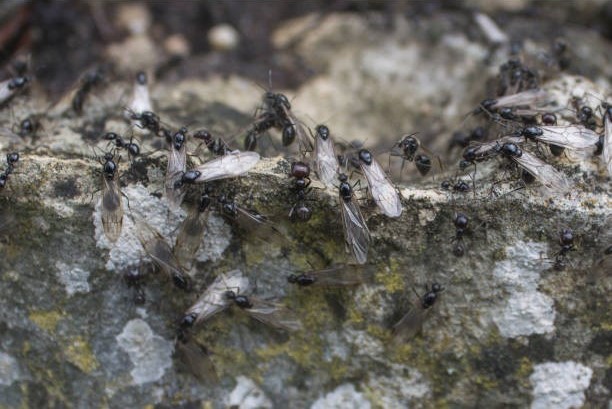Key Differences in Appearance
At first glance, swarmer termites and ant swarmers might seem alike, but a closer inspection shows distinct differences. The termite variety has straight antennae, equal-length wings, and thick, uniform bodies. Their ant counterparts have bent antennae, uneven wings, and a narrow, pinched waist. These traits may be subtle, but a quick look can determine which pest you’re dealing with.
Behavior and Nesting Habits
Swarmer termites typically appear after a rain shower and are on a mission to start new colonies. Once they have settled, they shed their wings and look for wood to call home. Since termites feed on cellulose, they’ll happily munch through support beams, flooring, and walls.
Ant swarmers also take flight to build new nests, but they tend to settle in less destructive areas, like cracks in concrete or under rocks. While they can be a nuisance, termites pose a much more significant threat to your home’s structural integrity.
Timing and Warning Signs
Swarming typically takes place in the spring or early summer for ants and termites, especially after a warm rain. However, the signs they leave behind differ. Termite swarmers often shed their wings near windowsills and light fixtures, and their presence can signal a hidden colony feeding on wood. You might notice softwood, blistered floors, or hollow-sounding beams.
Ant swarmers, on the other hand, may also be drawn to light but are less likely to indicate severe structural damage. They’re often found in kitchens, bathrooms, or near entry points, where they seek moisture and food. While seeing either pest indoors is a sign to investigate, termites usually signal a more urgent problem.
Damage Potential and Costs
Here’s where the stakes get high. Swarmer termites may be tiny, but they signal a colony that can silently chew through your home’s wooden structure 24/7. This kind of hidden destruction often goes unnoticed until repairs become expensive.
Ants, on the other hand, don’t eat wood. However, if the swarmers are carpenter ants, they may tunnel into damp materials—like drywall, door frames, or cabinets—to build their nests. Even so, their damage is easier to catch and far less destructive than what termites leave behind.
Call the Pros Before It Gets Worse
Don’t wait to find out the hard way whether you have swarmer termites or ant swarmers on your property. These flying invaders might be tiny, but the damage they leave behind can be significant. The sooner you act, the better your chances of avoiding costly repairs and structural issues. Contact Bennett Termite & Pest Solutions today to schedule an inspection and keep your home protected year-round.

